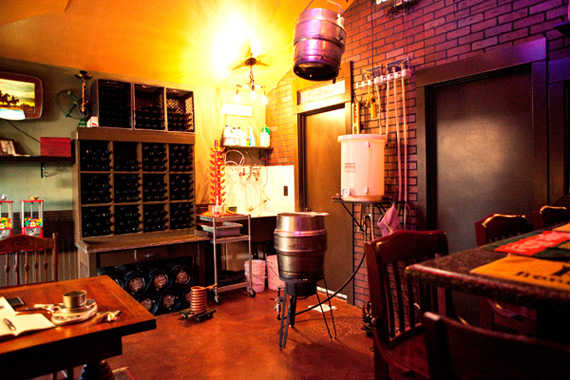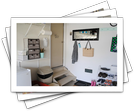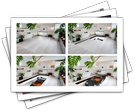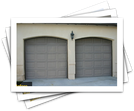http://www.sillys.com/
Southern Maine life Fun Things to do NANCY TIMBERLAKE RE/MAX Shoreline The Common at 88 Middle Street Portland, Maine 04101; (207) 553-7314 ntimberlake@homesinmaine.com
Food, Entertainment, and Arts

Wednesday, April 29, 2015
Friday, April 24, 2015
101 Things I Love about Portland Maine
Petit Jacqueline: Great Happy Hour with half price wine. Try the cheeses and meats or fromage et charcuterie!
Thursday, April 23, 2015
Prevent Flooding
How to Protect Your Home Against Flooding
- By: Gwen Moran
Few places in the country are considered free from flooding, so protect your home and family.
- Effort: Low 1 day-1 wknd
- Investment: Low $380-$785
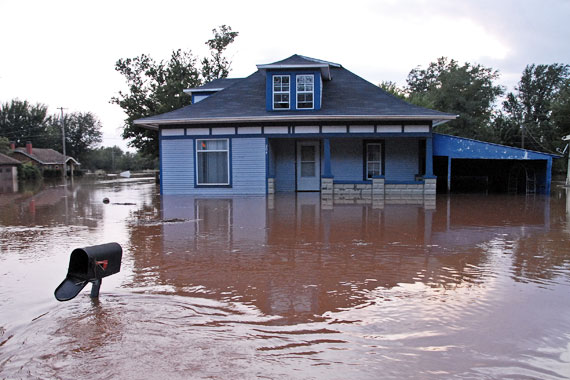 Always follow the direction of local and state authorities if ordered to evacuate during a flood. Image: Marvin Nauman/FEMA
Always follow the direction of local and state authorities if ordered to evacuate during a flood. Image: Marvin Nauman/FEMA
Flooding is the most common natural disaster in the United States, causing $2.7 billion in losses between 2001 and 2010, according to the National Flood Insurance Program, a government-sponsored pool that provides flood insurance to home owners.
Your homeowners insurance policy doesn’t cover flooding: You generally need to buy a separate flood insurance policy. The key to reducing flood damage is to take precautions, which in many cases you can accomplish in a few hours to a few days.
Your homeowners insurance policy doesn’t cover flooding: You generally need to buy a separate flood insurance policy. The key to reducing flood damage is to take precautions, which in many cases you can accomplish in a few hours to a few days.
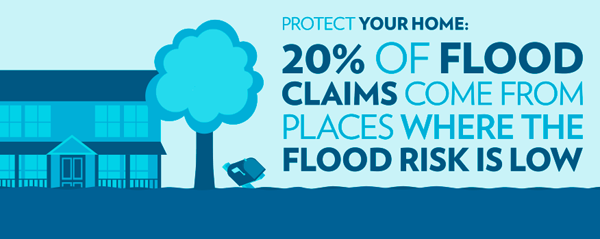
Protect Your Home
It’s not a good idea to bet the odds — 20% of flood claims come from places where the flood risk is low, according to floodsmart.gov. Check with your insurance agent to see what flood insurance will cost you. If you live in a community that participates in the National Flood Insurance Program, you can buy an NFIP flood policy. Participating communities agree to adopt and enforce ordinances that meet or exceed FEMA requirements to reduce the risk of flooding, according to NFIP.
Protect Yourself
If you live in a high-risk area, it’s a good idea to have a “go-bag” ready in case you need to leave quickly. Include:
- A few changes of clothing for you and family members
- Insurance policy numbers
- Phone numbers of your agent
- Your insurance company’s main number
- Essential toiletries
- Money to get you through a few days
Preventative measure: If you believe water will begin to accumulate in your home, shut off power at the main electrical panel in your home, says Bill Begal, owner of Begal Enterprises, a Rockville, Md., disaster restoration company. But never stand in water to do so — if the area around the box is already flooded, leave it alone.
In addition, know what to do in the first 24 hours after a flood to avoid additional risks to your health and home.
Keep Water from Damaging Your Home with Flood Control Tips
Before your rainy season or spring thaw begins, take these 10 steps to protect your home from water damage:
1. Fix leaks immediately. Leaky roofs and foundation cracks allow water to get into your home, which can weaken the structure and provide a perfect habitat for mold. When you see wet spots on the ceiling or cracks in the foundation, fix them as soon as it’s safe to get up on the roof or the material is dry enough to repair. Check that roofing shingles are secure.
2. Spring for extra roof protection. When it’s time to replace your roof, spend a few hundred dollars more to install a rubber roof underlayment, a waterproof barrier that goes under the shingles and protects the roof from water intrusion.
3. Close foundation cracks with mortar and masonry caulk or hydraulic cement, which expands and fills gaps completely and costs only a few dollars. Don’t patch solely with mortar or cement, which may crack again. If water is a recurring problem, be sure to investigate other solutions for issues like wet basements.
4. Clear gutters and drains. Keep gutters and drainage systems clear to carry water away from your home. Check storm drains on your street, as leaves and debris can block them, causing water to collect.
5. Invest in a battery-powered sump pump. Sump pumps let you pump water out of your home and can be an excellent defense against flooding — unless they’re powered by electricity and the power is out. Battery-powered sump pumps are a relatively inexpensive ($150-$400) solution.
6. Catalog possessions. Using a digital camcorder or camera, create a home inventory for insurance. Inexpensive digital cameras start at about $100. Although traditional video and photographs are adequate, they can be bulky to carry and may get damaged if left in a flooded home. Digital files can be stored on a small USB drive and kept in your go bag, sent to a friend or relative for safekeeping, or stored on an online backup system like idrive.com or opendrive.com, which offer a small amount of space to store files for free or a larger data storehouse for $50-$60 per year.
7. Move expensive items to a safer location. If you have a second floor or an attic, moving furniture, photographs, and artwork to a higher level will protect your possessions in all but the most severe floods. Elevate furnaces and water pumps when they’re installed, if possible, to a height of 12 inches above the highest known flood level for your area, suggests FEMA.
8. Anchor your fuel tanks. Unanchored tanks can float, rupture, and release fuel. Once the power sources of system units like furnaces and water heaters are disabled and the units cooled, you can also wrap them in waterproof tarps to mitigate water damage.
9. Prevent sewer backup. Install (or have a plumber install) sewer or septic line check valves, which allow waste to flow only one way. Plan to spend $100 or more per valve to have a pro install them, or do it yourself for $10-$15 each to ensure sewage can’t back up into the standing water in your home. Install at a point in the pipe that’s easy to access for repair.
10. Install French drains if you live on a slope and have a persistently wet basement or soggy lawn. A French drain collects water in your yard and diverts it safely away from your house.
Floods are a common challenge that many home owners will face at one time or another. However, by keeping your home in good repair, moving valuables out of water’s way, and creating good drainage around your home, you can stop or reduce potential flood damage.
Related: Are You Prepared to Evacuate Your Home in an Emergency?
Gwen Moran has written about finance and real estate for over a decade. Her work has been in Entrepreneur, Newsweek, and The Residential Specialist. A Jersey Shore resident, she’s weathered hurricanes, Nor’easters, and one earthquake.
Read more: http://www.houselogic.com/home-advice/disaster-insurance/protect-yourself-and-your-home-flooding/#ixzz3Y9fNnhRb
Follow us: @HouseLogic on Twitter | HouseLogic on Facebook
Monday, April 20, 2015
Wednesday, April 15, 2015
101 Things I Love about Portland Maine
Eventide Oyster bar has lots of goodies including best lobster roll in brown butter and chick pea fries!!
101 Things I Love about Portland Maine
New restaurant on Middle: Honey Paw noodle bar is latest from Eventide/Hugo's team. Wonderful interior!
Sunday, April 12, 2015
Garages
11 Inspiring Garage Remodeling Ideas
- By: John Riha
Want to add on without adding on? Converting your garage to living space may be the answer with these garage remodel ideas. And see how folks are reinventing living rooms, too.
Home Brewed
Where do some of the country’s best micro breweries get their start? Usually as home brews in a converted garage (the federal government allows up to 200 gallons of home brew in households with two or more people). This little brewery features pub comforts with a bar, TV, and even a stained concrete floor. To guard against unwanted temperature changes, you’ll want to insulate your garage door.
Credit: Brian Evans Photography
Credit: Brian Evans Photography
Image: Brian Evans Photography
See All Slideshows Read more: http://www.houselogic.com/photos/garages/garage-conversions/slide/home-brewed/#ixzz3X6LRey8d
Follow us: @HouseLogic on Twitter | HouseLogic on Facebook
Thursday, April 9, 2015
101 Things I Love about Portland Maine
Friday, April 3, 2015
Thursday, April 2, 2015
101Things I Love about Portland Maine
Vinland restaurant on Congress St: Fantastic all local food and most beverages.
Kitchen Trends
9 Kitchen Trends That Can’t Go Wrong
Remodeling your kitchen is a huge commitment. Make sure you’re getting the best return by making choices that’ll last. Here are 9 trends with staying power.
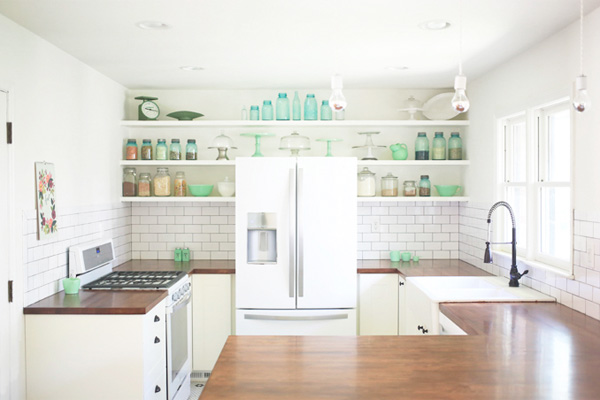 Swapping your stainless appliances for glossy white ones, like these from Whirlpool's White Ice collection, will give your kitchen lasting appeal. Plus, white appliances are much easier to keep clean. Image: Katy of All Sorts of Pretty
Swapping your stainless appliances for glossy white ones, like these from Whirlpool's White Ice collection, will give your kitchen lasting appeal. Plus, white appliances are much easier to keep clean. Image: Katy of All Sorts of PrettyYour kitchen is the one place where you want to be really careful about trendy choices. The last thing you want is a kitchen that’s out of sync in just a few years simply because you followed a trend. Instead, look at the trends in terms of the value they bring to your life and your home.
Here are nine trends that are popular now, but have staying power because they address lifestyle needs, convenience, and savings — ensuring you’ll enjoy your kitchen for many years.
1. Love White? You Won’t Go Wrong
It’s hard to believe that white kitchens could get any more popular. But the preference for white cabinets continues to soar. Sixty-seven percent of National Kitchen and Bath Association (NKBA) members said that white is their top choice for cabinets, a 20% climb from two years ago. And layering white on white — white backsplashes beneath white cabinets on white countertops — was spotlighted in the 2014 Best in American Living Awards presented by the National Association of Home Builders.
Whirlpool’s White Ice collection, with its glass-like glossy sheen, is being hailed as the first appliance exterior to rival stainless steel.
White appliances are so much easier to keep clean than stainless, which smudges if you as much as look at it. Plus, the new icy look is simple, cool, and able to blend into transitional and contemporary styles.
And since stainless has filtered down to the masses, it no longer has that expensive and exclusive cache it once had. But white will always have staying power.
Related: Why White Kitchens Stand the Test of Time
2. Want Color? Go for Neutral Gray
 Image: Beautiful Protest
Image: Beautiful Protest
The popularity of sleek, sophisticated gray color schemes is soaring. Seventy-one percent of NKBA designers said gray is the fastest-growing color scheme for kitchens in 2014.
But gray can be tricky. In cold, cloudy climates, gray can appear frozen unless you use it on warm materials like wood cabinets, or pair it with hot colors likes reds and yellows. On the other hand, gray can appear pleasantly cool in sunny, hot climates — a breath of fresh air in heat and humidity. So while white kitchens are a safe bet, gray is neutral enough — and close enough to white — to have staying power if you use it well.
Related: Wild Kitchen Colors, Practical Approaches
3. Embrace Smaller Appliances
Small is big these days. Micro-living is taking off for millennials and retirees. Owners of multigenerational homes are installing tiny, secondary kitchens for returning adult children and elderly parents.
Typically, these micro-kitchens feature a two-burner cooktop, combo microwave/convection oven, 18-inch dishwasher, and 60-inch fridge or refrigerator drawer.
GE, in fact, is developing an entire kitchen the size of a 6-foot-wide chest of drawers. The $15,000 unit — hey, small isn’t necessarily cheap — contains an induction cooktop, two ovens, a sink, a dishwasher, and two cooling drawers that can function as a fridge or freezer.
Related: Cool and Cute! Tiny Appliances for Tight Spaces
4. Choose Quartz Counters Over Granite
 Image: Bellingham from Cambria’s Waterstone Collection
Image: Bellingham from Cambria’s Waterstone Collection
In 2013, quartz and granite almost tied in countertop popularity. But in 2014, the trend is definitely toward quartz.
“Consumers Reports” says quartz is the toughest countertop material, which resists scratches, burns, and chips. Crushed quartz stone is mixed with resin to produce countertops that range from solid colors to the look of real granite, but they’ll beat natural stone in toughness. It’s easy to maintain, and unlike granite, you don’t have to seal it annually to prevent stains.
Related: Which Durable Countertop is Best for Your Kitchen?
5. Invest in LEDs
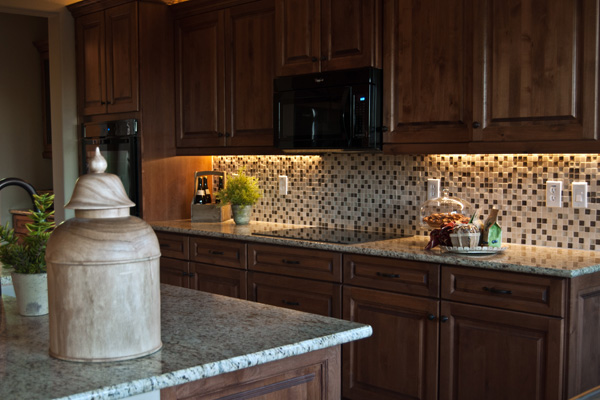 Image: Inspired LED
Image: Inspired LED
Ribbons of LEDs are showing up in the weirdest — and most wonderful — kitchen places: Along toe kicks as nightlights; on the inside of cabinet doors to show off grandma’s china; concealed in crown molding to wash ceilings with light.
LED rope or cove lights are gaining in popularity because:
Related: LEDs: Here’s How to Get the Most For Your Money
6. Rethink Your Fridge
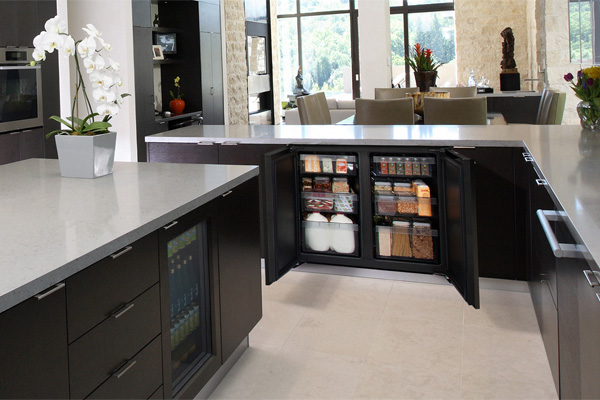 Image: U-Line / Photography: Douglas Johnson
Image: U-Line / Photography: Douglas Johnson
Refrigeration is no longer limited to a single, hulking unit. Homeowners are customizing their cooling needs with “point of use” refrigeration, adding cool where they need it.
That could mean adding a counter-height produce fridge in your prep island, next to a wine cooler for the adults, and a juice/soda fridge for the kids.
Don’t think we’re talking about dorm-fridge quality and prices. U-Line point-of-use refrigerators, for example, offer (depending on the model) 11 shelf positions, full-extension slide-out bins, and five food and beverage settings labeled deli, market, pantry, root cellar and beverage. Units typically sell for $2,500 to $4,000.
7. Install a Touch-Activated Faucet
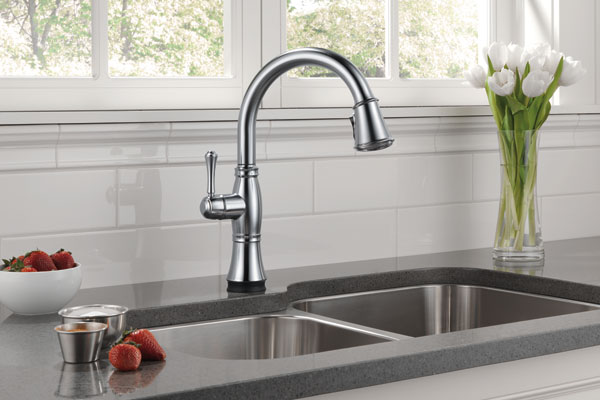 Image: Delta Faucet Company
Image: Delta Faucet Company
Touch-activated faucets are bursting out the fad category into the kitchen must-have column. In fact, in 2013 their popularity jumped to 30% from 20% the year before.
On the face of it, touch-activated seems a little gimmicky, and with prices starting around $350, it’s certainly a lot of money. But it’s great for those times when you’ve got dirty, chicken-goopy hands, and for those in your household who refuse to turn water on and off between tasks because it’s too much hassle. And as water becomes scarcer, anything that saves gallons will have value — and save you on your water bills.
A reason we recommend touch free over hands-free: As you know from public bathrooms with hands-free activiated faucets, they’ll often turn on when you don’t want them to and not turn on when you do.
Related: High-Tech Kitchen Faucet: A Hip, Smart Retrofit
8. Stick with Transitional Design
More than 60% of NKBA designers say contemporary, with its sleek simplicity, is the fastest-growing kitchen style. Fussy doodads and decorative and distressed glazes are out.
Contemporary looks sleek and clean, but can also come across as cold. The design encourages a non-cluttered look, which can be hard to maintain in a busy home. So it’s better to hedge your bets with transitional design, which combines contemporary and traditional to exploit the best parts of each.
9. Embrace Accessibility Because It’ll Make Your Life Easier
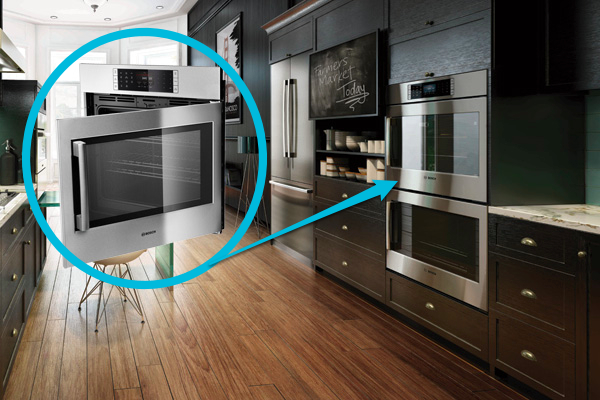 Image: Bosch Home Appliances
Image: Bosch Home Appliances
Aging in place is a big snore — until you get to that age when the right modifications will allow you to stay in your home. And since a large part of the population is reaching retirement age, accessibility finally is catching on — even with homeowners who aren’t intentionally seeking those features. Why? Because the designs make so much sense.
It’s not a trend that’s going away. The NKBA’s 2014 survey shows that 56% of designers specified accessible/universal design features in kitchens during 2013, and most believe they’ll add more and more features in the years to come.
Three here-to-stay trends:
1. Side-opening ovens at counter height: You don’t have to reach up or bend down to fetch your turkey, just comfortably slide it out. It’s one of those slap-your-forehead tweaks that make cooking so much more ergonomic and accessible for everyone.
2. Drawers with deep pockets: Base cabinets have evolved from back-bending storage for pots and pans to deep drawer space — typically 24 inches deep — that can hold just about everything in your kitchen.
Continuing that evolution — heck, let’s call a revolution — are deep drawer organizers, ranging from $7 to more than $200, that make sure everything stays in its place, rather than rumble around in chaos. You can customize drawers with:
1. Love White? You Won’t Go Wrong
It’s hard to believe that white kitchens could get any more popular. But the preference for white cabinets continues to soar. Sixty-seven percent of National Kitchen and Bath Association (NKBA) members said that white is their top choice for cabinets, a 20% climb from two years ago. And layering white on white — white backsplashes beneath white cabinets on white countertops — was spotlighted in the 2014 Best in American Living Awards presented by the National Association of Home Builders.
Whirlpool’s White Ice collection, with its glass-like glossy sheen, is being hailed as the first appliance exterior to rival stainless steel.
White appliances are so much easier to keep clean than stainless, which smudges if you as much as look at it. Plus, the new icy look is simple, cool, and able to blend into transitional and contemporary styles.
And since stainless has filtered down to the masses, it no longer has that expensive and exclusive cache it once had. But white will always have staying power.
Related: Why White Kitchens Stand the Test of Time
2. Want Color? Go for Neutral Gray
 Image: Beautiful Protest
Image: Beautiful ProtestThe popularity of sleek, sophisticated gray color schemes is soaring. Seventy-one percent of NKBA designers said gray is the fastest-growing color scheme for kitchens in 2014.
But gray can be tricky. In cold, cloudy climates, gray can appear frozen unless you use it on warm materials like wood cabinets, or pair it with hot colors likes reds and yellows. On the other hand, gray can appear pleasantly cool in sunny, hot climates — a breath of fresh air in heat and humidity. So while white kitchens are a safe bet, gray is neutral enough — and close enough to white — to have staying power if you use it well.
Related: Wild Kitchen Colors, Practical Approaches
3. Embrace Smaller Appliances
Small is big these days. Micro-living is taking off for millennials and retirees. Owners of multigenerational homes are installing tiny, secondary kitchens for returning adult children and elderly parents.
Typically, these micro-kitchens feature a two-burner cooktop, combo microwave/convection oven, 18-inch dishwasher, and 60-inch fridge or refrigerator drawer.
GE, in fact, is developing an entire kitchen the size of a 6-foot-wide chest of drawers. The $15,000 unit — hey, small isn’t necessarily cheap — contains an induction cooktop, two ovens, a sink, a dishwasher, and two cooling drawers that can function as a fridge or freezer.
Related: Cool and Cute! Tiny Appliances for Tight Spaces
4. Choose Quartz Counters Over Granite
 Image: Bellingham from Cambria’s Waterstone Collection
Image: Bellingham from Cambria’s Waterstone CollectionIn 2013, quartz and granite almost tied in countertop popularity. But in 2014, the trend is definitely toward quartz.
“Consumers Reports” says quartz is the toughest countertop material, which resists scratches, burns, and chips. Crushed quartz stone is mixed with resin to produce countertops that range from solid colors to the look of real granite, but they’ll beat natural stone in toughness. It’s easy to maintain, and unlike granite, you don’t have to seal it annually to prevent stains.
Related: Which Durable Countertop is Best for Your Kitchen?
5. Invest in LEDs
 Image: Inspired LED
Image: Inspired LEDRibbons of LEDs are showing up in the weirdest — and most wonderful — kitchen places: Along toe kicks as nightlights; on the inside of cabinet doors to show off grandma’s china; concealed in crown molding to wash ceilings with light.
LED rope or cove lights are gaining in popularity because:
- LEDs come in a rainbow of colors, from bright to soft white, red, blue, and green.
- You can get creative about where you install them.
- LEDs emit virtually no heat, so you can keep them on forever without burning cabinets or walls.
- LEDs are energy efficient, lasting 50,000 hours on average — five times longer than CFLs.
Related: LEDs: Here’s How to Get the Most For Your Money
6. Rethink Your Fridge
 Image: U-Line / Photography: Douglas Johnson
Image: U-Line / Photography: Douglas JohnsonRefrigeration is no longer limited to a single, hulking unit. Homeowners are customizing their cooling needs with “point of use” refrigeration, adding cool where they need it.
That could mean adding a counter-height produce fridge in your prep island, next to a wine cooler for the adults, and a juice/soda fridge for the kids.
Don’t think we’re talking about dorm-fridge quality and prices. U-Line point-of-use refrigerators, for example, offer (depending on the model) 11 shelf positions, full-extension slide-out bins, and five food and beverage settings labeled deli, market, pantry, root cellar and beverage. Units typically sell for $2,500 to $4,000.
7. Install a Touch-Activated Faucet
 Image: Delta Faucet Company
Image: Delta Faucet CompanyTouch-activated faucets are bursting out the fad category into the kitchen must-have column. In fact, in 2013 their popularity jumped to 30% from 20% the year before.
On the face of it, touch-activated seems a little gimmicky, and with prices starting around $350, it’s certainly a lot of money. But it’s great for those times when you’ve got dirty, chicken-goopy hands, and for those in your household who refuse to turn water on and off between tasks because it’s too much hassle. And as water becomes scarcer, anything that saves gallons will have value — and save you on your water bills.
A reason we recommend touch free over hands-free: As you know from public bathrooms with hands-free activiated faucets, they’ll often turn on when you don’t want them to and not turn on when you do.
Related: High-Tech Kitchen Faucet: A Hip, Smart Retrofit
8. Stick with Transitional Design
More than 60% of NKBA designers say contemporary, with its sleek simplicity, is the fastest-growing kitchen style. Fussy doodads and decorative and distressed glazes are out.
Contemporary looks sleek and clean, but can also come across as cold. The design encourages a non-cluttered look, which can be hard to maintain in a busy home. So it’s better to hedge your bets with transitional design, which combines contemporary and traditional to exploit the best parts of each.
9. Embrace Accessibility Because It’ll Make Your Life Easier
 Image: Bosch Home Appliances
Image: Bosch Home AppliancesAging in place is a big snore — until you get to that age when the right modifications will allow you to stay in your home. And since a large part of the population is reaching retirement age, accessibility finally is catching on — even with homeowners who aren’t intentionally seeking those features. Why? Because the designs make so much sense.
It’s not a trend that’s going away. The NKBA’s 2014 survey shows that 56% of designers specified accessible/universal design features in kitchens during 2013, and most believe they’ll add more and more features in the years to come.
Three here-to-stay trends:
1. Side-opening ovens at counter height: You don’t have to reach up or bend down to fetch your turkey, just comfortably slide it out. It’s one of those slap-your-forehead tweaks that make cooking so much more ergonomic and accessible for everyone.
2. Drawers with deep pockets: Base cabinets have evolved from back-bending storage for pots and pans to deep drawer space — typically 24 inches deep — that can hold just about everything in your kitchen.
Continuing that evolution — heck, let’s call a revolution — are deep drawer organizers, ranging from $7 to more than $200, that make sure everything stays in its place, rather than rumble around in chaos. You can customize drawers with:
- Slots to hold plates and store knives
- Dividers to keep your water bottles separate from your vinegar collection
- Stackable trays that keep utensils away from flatware
- Removable boxes that let you reorganize the drawers at will
 Lisa Kaplan Gordon is an avid gardener, a member of the Fairfax County Master Gardeners Association, and a builder of luxury homes in McLean, Va. She’s been a Homes editor for Gannett News Service and has reviewed home improvement products for AOL. Follow Lisa on Google+.
Lisa Kaplan Gordon is an avid gardener, a member of the Fairfax County Master Gardeners Association, and a builder of luxury homes in McLean, Va. She’s been a Homes editor for Gannett News Service and has reviewed home improvement products for AOL. Follow Lisa on Google+.Read more: http://www.houselogic.com/home-advice/kitchens/9-kitchen-trends-that-cant-go-wrong/#ixzz3WBGryMWJ
Follow us: @HouseLogic on Twitter | HouseLogic on Facebook
Wednesday, April 1, 2015
Subscribe to:
Posts (Atom)












